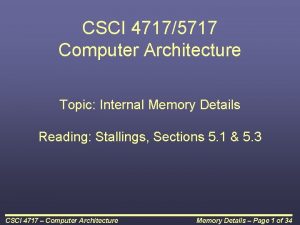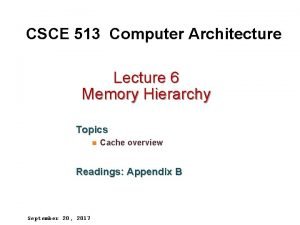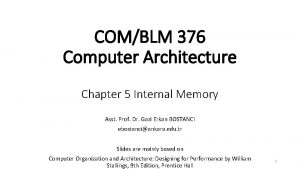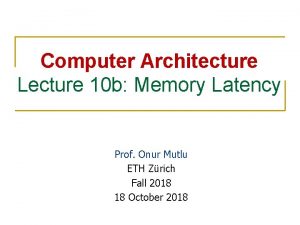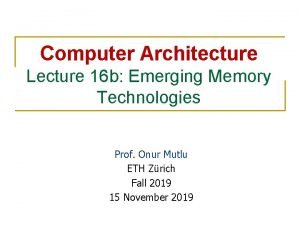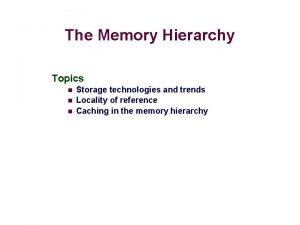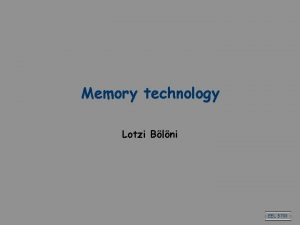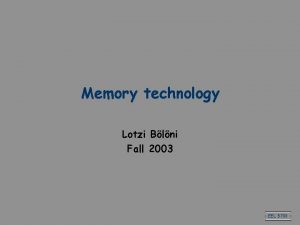EEL 5708 High Performance Computer Architecture Review Memory










- Slides: 10

EEL 5708 High Performance Computer Architecture Review: Memory Hierarchy September 10, 2004 Lotzi Bölöni Fall 2004 EEL 5708/Bölöni Lec 4. 1

Acknowledgements • All the lecture slides were adopted from the slides of David Patterson (1998, 2001) and David E. Culler (2001), Copyright 1998 -2002, University of California Berkeley Fall 2004 EEL 5708/Bölöni Lec 4. 2

The Memory Abstraction • Association of <name, value> pairs – typically named as byte addresses – often values aligned on multiples of size • Sequence of Reads and Writes • Write binds a value to an address • Read of address returns most recently written value bound to that address command (R/W) address (name) data (W) data (R) done Fall 2004 EEL 5708/Bölöni Lec 4. 3

Recap: Who Cares About the Memory Hierarchy? Processor-DRAM Memory Gap (latency) Performance 1000 µProc 60%/yr. (2 X/1. 5 yr ) Processor-Memory Performance Gap: (grows 50% / year) DRAM 9%/yr. (2 X/10 yrs) CPU “Joy’s Law” 100 10 1981 1982 1983 1984 1985 1986 1987 1988 1989 1990 1991 1992 1993 1994 1995 1996 1997 1998 1999 2000 1 Time Fall 2004 EEL 5708/Bölöni Lec 4. 4

Levels of the Memory Hierarchy Upper Level Capacity Access Time Cost CPU Registers 100 s Bytes <1 s ns Cache 10 s-100 s K Bytes 1 -10 ns $10/ MByte Main Memory M Bytes 100 ns- 300 ns $1/ MByte Disk 10 s G Bytes, 10 ms (10, 000 ns) $0. 0031/ MByte Tape infinite sec-min $0. 0014/ MByte Fall 2004 Staging Xfer Unit faster Registers Instr. Operands prog. /compiler 1 -8 bytes Cache Blocks cache cntl 8 -128 bytes Memory Pages OS 512 -4 K bytes Files user/operator Mbytes Disk Tape Larger Lower Level EEL 5708/Bölöni Lec 4. 5

The Principle of Locality • The Principle of Locality: – Program access a relatively small portion of the address space at any instant of time. • Two Different Types of Locality: – Temporal Locality (Locality in Time): If an item is referenced, it will tend to be referenced again soon (e. g. , loops, reuse) – Spatial Locality (Locality in Space): If an item is referenced, items whose addresses are close by tend to be referenced soon (e. g. , straightline code, array access) • Last 15 years, HW (hardware) relied on locality for speed Fall 2004 EEL 5708/Bölöni Lec 4. 6

Memory Hierarchy: Terminology • Hit: data appears in some block in the upper level (example: Block X) – Hit Rate: the fraction of memory access found in the upper level – Hit Time: Time to access the upper level which consists of RAM access time + Time to determine hit/miss • Miss: data needs to be retrieve from a block in the lower level (Block Y) – Miss Rate = 1 - (Hit Rate) – Miss Penalty: Time to replace a block in the upper level + Time to deliver the block the processor • Hit Time << Miss Penalty (500 instructions on 21264!) To Processor Upper Level Memory Lower Level Memory Blk X From Processor Fall 2004 Blk Y EEL 5708/Bölöni Lec 4. 7

Computer System Components Proc Caches Buses Memory adapters Controllers I/O Devices: Disks Displays Keyboards Networks • All have interfaces & organizations • Bus & Bus Protocol is key to composition => peripheral hierarchy Fall 2004 EEL 5708/Bölöni Lec 4. 8

A Modern Memory Hierarchy • By taking advantage of the principle of locality: – Present the user with as much memory as is available in the cheapest technology. – Provide access at the speed offered by the fastest technology. • Requires servicing faults on the processor Processor Control Speed (ns): 1 s Size (bytes): 100 s Fall 2004 On-Chip Cache Registers Datapath Second Level Cache (SRAM) Main Memory (DRAM) 10 s 100 s Ks Ms Tertiary Secondary Storage (Disk/Tape) (Disk) 10, 000 s 10, 000, 000 s (10 s ms) (10 s sec) Gs Ts EEL 5708/Bölöni Lec 4. 9

Summary • Modern Computer Architecture is about managing and optimizing across several levels of abstraction wrt dramatically changing technology and application load • Key Abstractions – instruction set architecture – memory – bus • Key concepts – – HW/SW boundary Compile Time / Run Time Pipelining Caching • Performance Iron Triangle relates combined effects – Total Time = Inst. Count x CPI x Cycle Time Fall 2004 EEL 5708/Bölöni Lec 4. 10
 Memory system
Memory system Explain virtual memory in computer architecture
Explain virtual memory in computer architecture Computer architecture
Computer architecture Advanced dram organization
Advanced dram organization Memory hierarchy
Memory hierarchy Memory organization in computer architecture
Memory organization in computer architecture Internal memory in computer architecture
Internal memory in computer architecture Latency in computer architecture
Latency in computer architecture Emerging memory technologies
Emerging memory technologies Memory hierarchy
Memory hierarchy Computer architecture performance evaluation methods
Computer architecture performance evaluation methods



